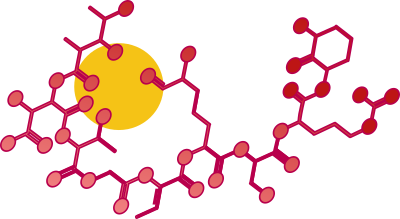A strange species of bacteria, Delftia acidovorans, has evolved the unique ability to collect gold. Harnessing this ability could have world-changing applications in the gold industry, ecology, medicine, and elsewhere. Annotating scientific literature can help us add to the existing collection of knowledge, and work towards building a literature review to collect Delftia knowledge and identify areas where more work is needed.
Current Knowledge of Delftia
Heavy metals are found naturally in Earth’s crust. Some, like mercury or lead, can be very harmful to living things when present in high concentrations. In some soils, toxic gold is the main threat. To survive these hostile environments, the bacterial species Delftia acidovorans has evolved a way to scavenge for gold and accumulate it into a harmless gold nugget.
Research has identified a molecule involved in the gold interactions– a peptide named delftibactin. This molecule is secreted by Delftia cells into the environment, where it captures toxic gold. Delfibactin converts gold ions into nanoparticles, which are unable to enter the cell and cause damage. Over time, the nanoparticles accumulate into visible gold deposits.

Despite identifying D. acidovorans ability to produce solid gold, few studies have been conducted (little research has been undertaken?) to further our understand this phenomenon. Several papers have been published, proposing or demonstrating the use of this bacteria for gold sensing, recycling gold from discarded electronics, and extracting gold from the ocean. Additionally, D. acidovorans may be of notable importance in environmental heavy metal cycling, and an important resident of biofilms.
Gold has unique properties that make it ideal for use in certain applications. Its conductivity is perfect for use in electronics, and its ability to reflect infrared radiation is great for use in spacesuits and spacecraft. Society’s growing demand has made obtaining gold more about advancing technology, and less about gaining personal wealth.
Although these applications have been proposed, little work has been done to characterize the pathways and molecules involved in Delftia‘s interactions with gold. It is unknown how the activities of delftibactin are affected by temperature, pH, or interactions with other molecules. A similar peptide produced by D. acidovorans that also binds gold was discovered but has yet to be characterized.
Understanding the genes involved in D. acidovorans gold interactions is essential for developing industrial applications. To take advantage of this system and increase its efficiency, we must identify the regulatory pathways, peptide activities, and other aspects of this phenomenon.
Why Should You Annotate?
Collaborative annotation is used to create an open dialogue to add a “second layer” of peer review to research articles. By discussing, asking questions, and sharing opinions, your annotations can help us uncover the secrets of Delftia. Annotations can improve the quality of research, increase public visibility, and generate interest for future studies to promote the development of applications for D. acidovorans.
Participating in social annotation benefits you by
- Giving you a voice in critical conversations about Delftia research
- Expands your scientific knowledge through conversations and collaborative learning
- Do your duty of “making your mark” and contribute to advancements in science and technology
- Help more people understand the potential of Delftia by providing background information or personal knowledge. Contribute to public sci literacy and public trust in science (more societal than personal benefit)
How Should You Annotate?
A good way to prepare for annotation is to familiarize yourself with the topic and article. Read the paper, taking the time to note the research problem, main findings, and any questions you may have. Use existing annotations and our graphic summaries to deepen your understanding of the research.
See the example summary of one of our favorite articles, “Gold biomineralization by a metallophore from a gold-associated microbe”. By using this information, you can easily read the research paper and find out how scientists found delftibactin and shed new light onto Delftia‘s gold activities. Scientists found gold precipitate, genes for a metal-binding protein, and a peptide with a metal-binding site. They used this information to conclude that the peptide they observed was responsible for Delftia‘s unique gold-associated activities, named delftibactin! Interestingly, researchers found that delftibactin reacts with gold in two different ways, and can produce both round (colloidal) and octahedral types of gold particles.

Good annotations contribute to the public discussion in a meaningful and respectful way. Once you are familiar with the material, add new annotations or contribute to existing conversations. We suggest you add your personal perspectives or experiences on the topic, comments or ideas about methods or findings, and asking questions for our student Delftia experts to answer.
Want to take your annotation to the next level?
- Connect information to other articles that provide supporting or conflicting results.
- Link online resources (videos, graphics, photos) that help explain research methods or concepts.
- Create your own “artifacts” by producing graphic organizers, illustrations, or other materials related to the research.